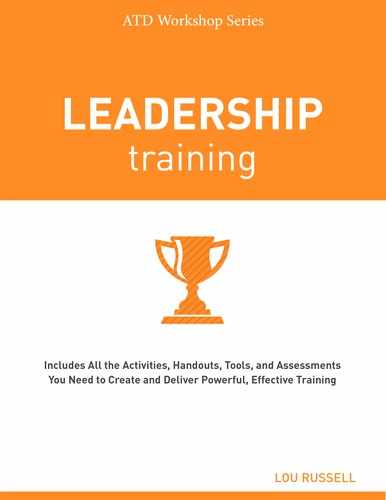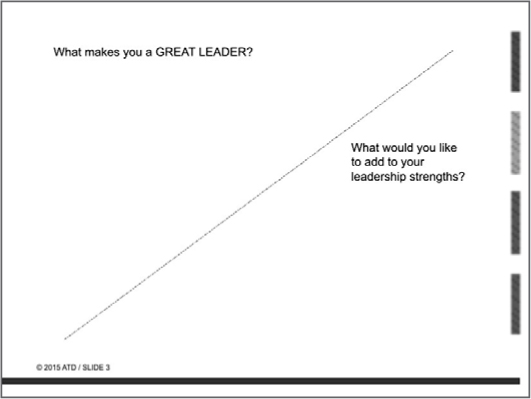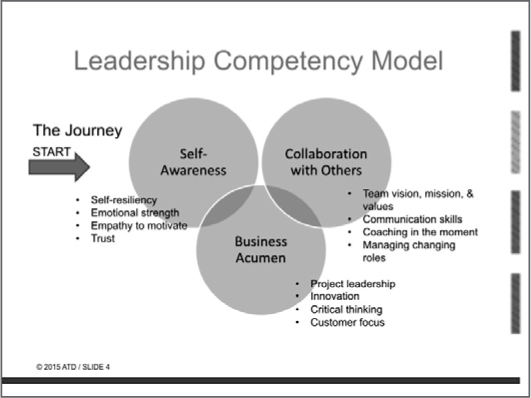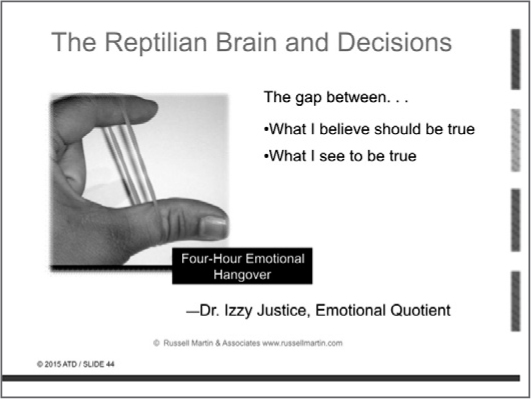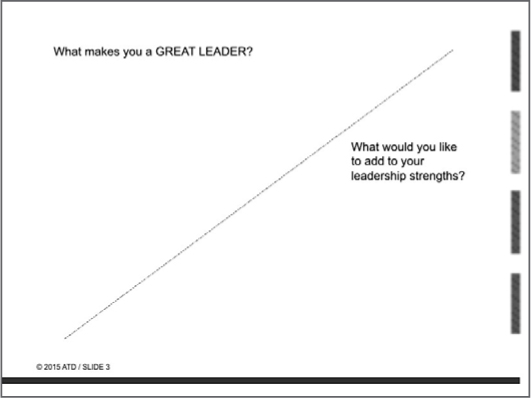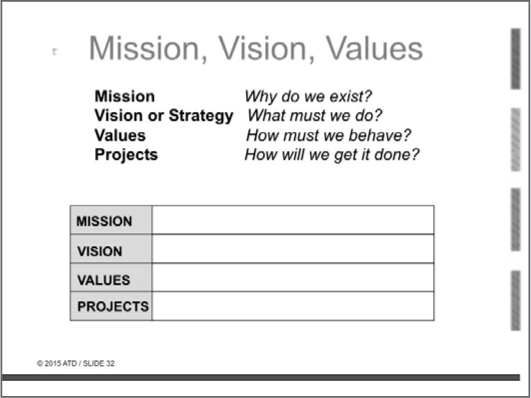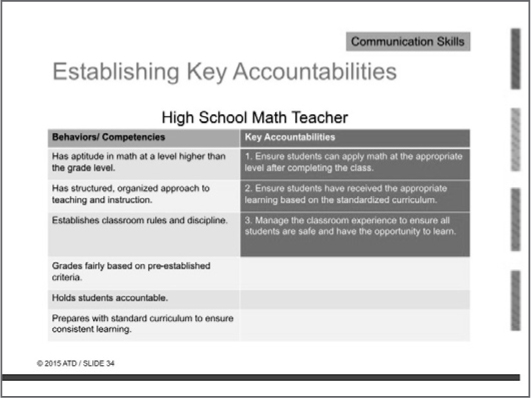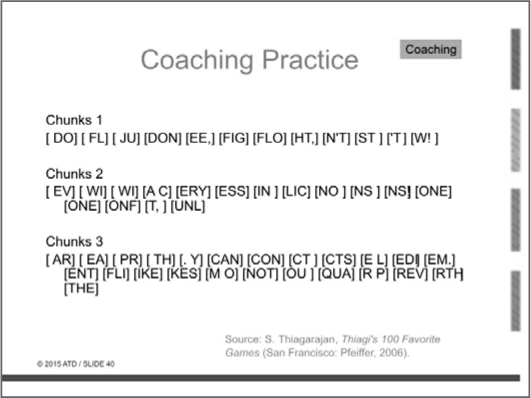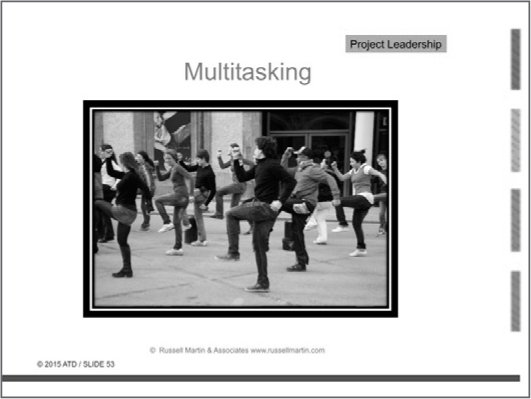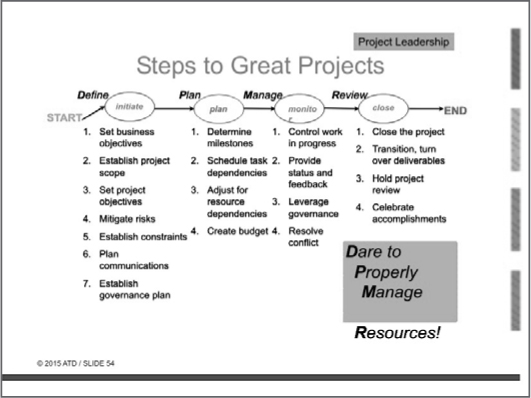Chapter 3
Two-Hour Leadership Workshop
What’s in This Chapter
• Objectives of the two-hour Leadership Workshop
• Summary chart for the flow of content and activities
• Preparing for the Leadership Workshop, including pre-work suggestions
• Two-hour program agenda
When creating a two-hour workshop, the time constraints present you with two choices: choose one leadership theme and explore it more thoroughly, or choose several leadership topics and discuss them in less depth. The challenge is that the workshop provides little time to practice the skills; at the end of the day participants may leave the workshop with a lot of information and very little practiced skill. My belief is that it is better to select a smaller set and learn applicable skills than it is to breeze over many.
If you choose a deeper dive into a specific theme, participants have the opportunity to practice and retain new skills. The content for the two-hour workshop presented in this chapter focuses on three groupings of competencies: self-awareness, collaboration with others, and business acumen. I prefer to build in this order. Depending on the needs of your learners, it may be an effective strategy to pick one of the categories for a deep dive. Alternatively, you could select the area of greatest need (for example, one competency) for each group. The one-day version of the workshop provides a deeper dive into each competency, but that is still not sufficient time for skills to be built. The two-day version takes a completely different approach, focusing on a simulation that requires each leader to choose and apply the best competency for the moment, seamlessly integrating and acting within all the competencies. Chapter 4 gives other options for customizing the content and activities for specific business needs.
Any workshop, regardless of length, benefits from incorporating the principles of active training. This workshop is designed to present activities that engage participants in relevant and meaningful learning experiences, small group discussion, and skills practice. Be sure to allow time for discussion and reflection to enhance learning and retention.
Two-Hour Workshop Objectives
By the end of the two-hour workshop, participants will be able to
• Leverage an online assessment to establish their baseline strengths and motivators
• Self-assess against the leadership competencies
• Create a personal development plan to grow aptitude in competency themes of self-
awareness, collaboration with others, and business acumen.
Before the Workshop: Pre-Work
Self-awareness is a key component of growing leadership competency. Online assessments are useful tools for this goal. We highly recommend the TTI Success Insights tools (three-part TriMetrix EQ) and the online 360 OD Survey, which enables learners to receive valuable feedback from their supervisors, peers, and direct reports. This 360-degree feedback when used with the TriMetrix EQ assessment creates consistent facts regarding the strengths and blind spots of the learner/leader. The results in total are used to create personal development plans. Chapter 13 will explain more about the assessments built into this workshop. Please read the introduction chapter and Chapter 13 carefully before planning this program. They give detailed information about using these profiles or substituting your own. We understand that with a shorter workshop program that you may not have the time or the budget to use formal, research-based assessment tools such as the TriMetrix EQ assessments. For that reason, Chapter 13 also gives guidance on alternative activities and a paper 360-degree feedback option.
Two-Hour Workshop Overview
| TOPICS | TIMING |
| Welcome and Introduction | 1 minute |
| Learning Activity 2: Inspirational Leader | 9 minutes |
| Leadership Competency Model | 2 minutes |
| Self-Assessment/Assessment 1: 360 Leadership Competency Assessment | 3 minutes |
| Self-Awareness Competencies | 2 minutes |
| Learning Activity 3: Personal Mission | 13 minutes |
| Individual Reflection | 5 minutes |
| Emotional Strength | 10 minutes |
| Reflection | 5 minutes |
| Collaboration with Others Competencies | 1 minute |
| Learning Activity 6: Team Vision, Mission, and Values | 9 minutes |
| Learning Activity 8: Key Accountabilities | 10 minutes |
| Learning Activity 9: Chunks | 10 minutes |
| Change Versus Transition | 5 minutes |
| Reflection | 2 minutes |
| Business Acumen Competencies | 3 minutes |
| Project Leadership | 5 minutes |
| Learning Activity 14: Triangles | 3 minutes |
| Customer Focus | 2 minutes |
| Individual Reflection | 5 minutes |
| Learning Activity 15: Sticky Note Pass | 10-15 minutes |
| Wrap-Up | 5 minutes |
| TOTAL | 120 Minutes (2 Hours) |
Two-Hour Workshop Agenda
The focus of this two-hour workshop is to introduce the 21st Century Leadership Competencies and build a plan to help grow individual competencies.
| Two-Hours: (8:00 a.m. to 10:00 a.m.) | ||
| TIMING | SLIDES | Activities/Notes/Considerations |
|
8:00 a.m. (1 min) |
Slide 1
|
Welcome and Introduction Arrive early to set up the room and make sure everything works properly. Adjust the room set-up as needed. Welcome everyone as they arrive. Briefly introduce yourself. |
|
8:01 a.m. (9 min) |
Slide 2
|
Learning Activity 2: Inspirational Leader To get participants thinking about leadership, ask them to use their cell phones, tablets, or computers to find a picture of a leader who inspires them. If they don’t have access to those devices, they can just choose a leader. Ask them each to share who it is and how they are inspired. Talk a little bit about blind spots of these leaders as well. Transition into the next activity to help them begin to think about their own leadership strengths and blind spots. (Slide 1 of 2) |
|
Slide 3
|
Learning Activity 2: Inspirational Leader • Handout 2: Inspirational Leader Now ask participants to think about their own leadership. Direct them to fill out Handout 2 by answering questions about what makes them a great leader and what they would like to add to their leadership strengths. Follow instructions in the learning activity. (Slide 2 of 2) |
|
|
8:10 a.m. (2 min) |
Slide 4
|
Learning Content/Lecture Leadership Competency Model • Handout 13: Leadership Scorecard Introduce the competency model briefly. Explain how each competency rolls up into one of three categories: self-awareness, collaboration with others, and business acumen. Pass out a copy of the model to each participant (Handout 13.) You may also consider providing them with a copy of the ATD Infoline “Critical Competencies for 21st Century Leaders.” |
|
8:12 a.m. (3 min) |
Slide 5
|
Self-Assessment • Assessment 1: 360 Leadership Competency Assessment Pass out Assessment 1 and have participants fill it out. If you are using the online 360 OD Survey, ask participants to review their aggregate report. (This slide is an image of the first page only.) |
|
8:15 a.m. (2 min) |
Slide 6
|
Learning Content/Lecture Self-Awareness Competencies Refer participants back to the Leadership Competency Model. Transition into the self-awareness category of competencies, which will set up discussion of assessment tools. The competencies in the self-awareness category are self-resiliency, emotional strength, empathy to motivate, and trust. |
|
8:17 a.m. (13 min) |
Slide 7
|
Learning Activity 3: Personal Mission This activity invites participants to build a personal mission statement, which will be the “base” they come back to when their workload and focus are in chaos. It will help them answer the question: Why am I here? Begin by sharing an example of a personal mission statement (it can be your own, or you can use the author’s: Ignite, affirm, and sustain learning in self and others). |
|
8:30 a.m. (5 min) |
Slide 8
|
Individual Reflection/Discussion • Handout 3: Have, Want, Don’t Want Direct participants to work individually and reflect on what they have and want in their lives. Ask them to think about what they would like their lives to be. The question prompts in the handout will help guide their answers. Debrief by asking people to share any “aha” moments with the larger group. Or you can ask them to share their insights with the people at their tables. |
|
8:35 a.m. (10 min) |
Slide 9
|
Learning Content/Lecture Emotional Strength Use this slide to introduce the leadership competency of emotional strength (emotional intelligence) to your participants. Focus your discussion on two aspects of emotional intelligence: emotional awareness and regulation. (Empathy stems from managing these two.) Explain that emotions create a physical reaction in your body that may prevent you from making the best decisions. It’s like looking at the world through muddy versus clear water: You cannot see your choices well. As emotional beings, we are fluid and constantly changing. And one property of all fluids is that they are more vulnerable to outside stimulus. This is true of emotions as well. When you’re in a strong emotional (negative or positive) state, it actually changes what you see, just like looking through muddy water. This affects your decision making and can drive conflict and cause mistakes and rework. (Slide 1 of 5) |
|
Slide 10
|
Learning Content/Lecture Example of Poor Emotional Intelligence Share example of poor emotional awareness and regulation: • The JetBlue flight attendant incident in which Steven Slater got upset with a passenger after the passenger would not sit down while the plane was still taxiing. Slater then decided to quit and deployed the emergency exit out the side of the plane. • Underline for the participants that he had been diagnosed HIV positive two weeks prior to this series of bad choices. He was truly dealing with life and death and projecting onto passengers and suitcases. • For more details see notes in the PowerPoint slide or read story on Wikipedia. (Slide 2 of 5) |
|
|
Slide 11
|
Learning Content/Lecture Example of Good Emotional Intelligence Share example of amazing emotional awareness and regulation: • Chesley Burnett “Sully” Sullenberger III is an American airline pilot who became famous when he successfully landed a U.S. Airways aircraft in the Hudson River saving all 155 passengers and crew aboard. • For more details see notes in the PowerPoint slide or read story on Wikipedia. (Slide 3 of 5) |
|
|
Slide 12
|
Learning Content/Lecture Brain Reaction to Threats The reptilian part of the brain is primitive and automatic because it evolved to keep you alive. The limbic (emotional) brain continuously scans for trouble. When the emotional brain engages the reptilian part of the brain, your choices are limited to fight, flight, or freeze. Engaging the reptilian brain, however, is not an on-off switch; it’s more of a slow ramp-up, leaving about 90 seconds to “catch it” (awareness/regulation). When the reptilian brain is engaged, you cannot access the frontal lobe where if-then-else and cause-and-effect thinking and decision making takes place, nor can you access the neocortex where memories such as “I’ve seen something like this before and learned to do this” are stored. Use the JetBlue story to explore how the flight attendant likely did not have access to his frontal lobe and neocortex. (Slide 4 of 5) |
|
|
Slide 13
|
Learning Content/Lecture The Reptilian Brain and Decisions Your limbic (or emotional) brain has an opinion about the way things should be (just like a rubber band stretching between your fingers causes discomfort). When it senses a gap between what is and what should be, it activates the reptilian brain, which can’t differentiate between a tiger and a mean email. Dr. Izzy Justice proved that a strong negative response (reptilian brain) affects or blocks your ability to make decisions for four hours on average. (Slide 5 of 5) |
|
|
8:45 a.m. (5 min) |
Slide 14
|
Reflection Handout 2: Inspirational Leader Quickly summarize the morning’s topics for the participants. Ask them to add notes to Handout 2 started earlier in the workshop. |
|
8:50 a.m. (1 min) |
Slide 15
|
Learning Content/Lecture Collaboration with Others Competencies Remind learners about the Leadership Competency Model. This morning you concentrated on the self-awareness competencies. Now you are transitioning to the competencies included in the collaboration with others category: team mission, vision, and values; communication skills; coaching in the moment; and managing changing roles. |
|
8:51 p.m. (9 min) |
Slide 16
|
Learning Activity 6: Team Mission, Vision, and Values • Handout 32: Mission, Vision, and Values Worksheet This slide presents the mission, vision, and values of a large, well-known corporation. Using the example as a springboard, ask participants why having a team mission, vision, and values is important. Use this conversation to transition into the activity. (Slide 1 of 2) |
|
Slide 17
|
Learning Activity 6: Team Mission, Vision, and Values • Handout 32: Mission, Vision, and Values Worksheet This activity helps participants draft team vision, mission, and values statements for their real teams back in the workplace. Give them 14 minutes to fill in the worksheet. Then direct them to share their statements with their table teams. Lead a debrief by encouraging each team to share their best example with the entire group. (Slide 2 of 2) |
|
|
9:00 a.m. (10 min) |
Slide 18
Note: Consider cutting Learning Activity 8 (Slides 18 and 19) if you are having trouble fitting all the activities into the two-hour timeframe. |
Learning Activity 8: Key Accountabilities • Handout 33: Determining Your Key Accountabilities This activity will help participants identify key accountabilities and how they relate to their jobs. Key accountabilities are about jobs, and competencies are about people. Each job has three to five key accountabilities (that is, measureable statements of what must be done in the job for the business or organization to be successful). For example, a competency could be “communication skills” but what if the person never communicates? A related key accountability might be “effectively negotiates using good communication skills for cost-effective contracts with vendors.” Instruct participants to use back of handout to identify and jot down three key accountabilities for a high school math teacher. To determine accountabilities, they should ask themselves this question: What does the teacher have to do each day to support the mission of the school? Lead a brief group discussion on how to “boil down” the job description into three key accountabilities. (Slide 1 of 2) |
|
Slide 19
|
Learning Activity 8: Key Accountabilities • Handout 33: Determining Your Key Accountabilities Present slide to demonstrate a possible solution and ask them to share their thoughts about this. Now, tell them it is their turn. Ask participants to identify their top three key accountabilities and write them on Handout 33. Debrief the activity by asking volunteers to share one of their key accountabilities. (Slide 2 of 2) |
|
|
9:10 a.m. (10 min) |
Slide 20
|
Learning Activity 9: Chunks • Handout 6: Hints and Solutions for Coaching This activity will help participants develop effective coaching skills. Introduce the activity with an example of a chunks puzzle on this slide. (Slide 1 of 3) |
|
Slide 21
|
Learning Activity 9: Chunks • Handout 6: Hints and Solutions for Coaching Explain that each chunks item on the slide is a sentence cut up into three-character chunks (including the spaces and punctuation marks). Follow the instructions in the learning activity to conduct the activity. Discuss the activity by asking the debriefing questions listed in the learning activity. (Slide 2 of 3) |
|
|
Slide 22
|
Learning Activity 9: Chunks Close the activity by reminding the participants that asking is a big part of coaching. Share Mike’s list of really powerful questions on this slide. Distribute page 2 of Handout 6, which includes entire list of questions. (Slide 3 of 3) |
|
|
9:20 a.m. (5 min) |
Slide 23
|
Learning Content/Lecture Change Versus Transition Explain the difference between change and transition: Change happens to us, whereas transition is a conscious choice. (Slide 1 of 2) |
|
Slide 24
|
Learning Content/Lecture Change Model Review slide with the participants. It shows William Bridges’ change model from his book Managing Transitions (1991). His model helps people begin to think about the phases of change. Bridges believes that we all go through these three phases to realize a successful transition: • Endings: This phase is a mourning phase and requires acknowledgment of loss before moving on. • Neutral zone: As it was on Star Trek, this is an unsafe place. When here, you feel as if you are lost and need to get out, but many people can’t bring themselves to move forward. Unable to go back, they find themselves stuck here forever. • New beginning: Moving into this phase requires acknowledgment of possibilities and opportunities. Now focus on the emotions shown in the model, which are associated with the three phases of transition. It is important to remind participants that people do not always go through these phases or emotions in a linear way—at any one time they might move backward or forward. Share a real story to demonstrate the path through these emotions. Or you could use a movie plot that most people are familiar with (for example, Frozen). (Slide 2 of 2) |
|
|
9:25 a.m. (2 min) |
Slide 25
|
Reflection • Handout 2: Inspirational Leader Ask participants to reflect on what they have been learning this afternoon. Encourage them to add their notes and insights to Handout 2 started earlier in the workshop. |
|
9:27 a.m. (3 min) |
Slide 26
|
Learning Content/Lecture Business Acumen Competencies Refer learners back to the Leadership Competency Model presented early in the workshop. This afternoon you have concentrated on the competencies in the collaboration category. Now you are transitioning to the business acumen competencies: project leadership, innovation, critical thinking, and customer focus. A key question that drives these competencies is this: How do you work on the right things with the right people at the right time? |
|
9:30 a.m. (5 min) |
Slide 27
|
Learning Content/Lecture Project Leadership Explain how work, especially project work, is done like a flash mob. In today’s work environment with increased multitasking and matrixed reporting, people work in small, unfocused meetings, moving by the hour between one team and another, never really making much progress. Leadership demands focus, prioritization, and attention. All this multitasking is very hard on the brain and can cause us to lose focus and underperform. It’s likely that in this very workshop, people are sneaking a look at their email every chance they get. Consider discussing the impact of this on learning to keep the group focused. (Slide 1 of 2) |
|
Slide 28
|
Learning Content/Lecture Steps to Great Projects Present the four steps to great projects. Ask how many of them jump right to the schedule when they start a project. Then ask: How can you schedule what you don’t understand? Share that great projects have a clear, minimal process: • Define: answers the question why are we spending money on this project instead of another?
• Plan: now that we know why, we can figure out the best how (project management software begins here)
• Manage: adapt to change (ask them to cross out control; no such thing exists in projects)
• Review: learn to be a better project manager
The Project Management Institute (PMI) chooses the best practices of project management and documents them in the Project Management Body of Knowledge (PMBOK). Some of the terminology used in the standards is different than the way many people talk about projects. To illustrate this, notice that the labels in blue on the slide are from the PMBOK, whereas the terms define-plan-manage-review are more commonly used. (Slide 2 of 2) |
|
|
9:35 a.m. (3 min) |
Slide 29
|
Learning Activity 14: Triangles • Handout 12: Triangles This activity helps participants sharpen their critical thinking skills, which are important tools in their business acumen toolbox. Follow the instructions in the learning activity and facilitate a discussion about what they learned doing the exercise. |
|
9:38 a.m. (2 min) |
Slide 30
|
Learning Content/Lecture Customer Focus Customer focus is another important component of business acumen. Ask participants: • Who is your team’s customer (internal customers, not external)? • What does your customer want from you? What does your customer value? • What do you deliver to your customer? Is it different? Which need wins? • How can we help our customer’s customer? |
|
9:40 a.m. (5 min) |
Slide 31
|
Individual Reflection • Handout 2: Inspirational Leader Ask participants to think about what they have learned and experienced in today’s workshop. Encourage them to add their notes and insights to Handout 2 one last time. Then ask participants to reflect on this slide and answer its question privately. |
|
9:45 a.m. (10-15 min) |
Slide 32
|
Learning Activity 15: Sticky Note Pass This activity offers a fun, interactive game to share lessons learned and close the session in an insightful and reflective way. Follow the instructions in the learning activity. Award prizes for the sticky notes with the most points. |
|
9:55 a.m. (5 min) End 10:00 a.m. |
Slide 33
|
Wrap-Up This slide presents additional resources to help participants continue the learning started today. Be open to answer any final questions from the participants on leadership or the concepts presented in the workshop. Conduct course evaluations if applicable. Share plans for follow-up coaching if applicable (see Chapters 10 and 11 for ideas to follow up the training with support and activities). Optional: • Handout 28: Course Evaluation |
What to Do Next
• Determine the schedule for training classes; reserve location and any catering you may wish to provide.
• Identify and invite participants.
• Inform participants about pre-work if you will be using it in the workshop. If you are using online assessments leave at least a week to send links to participants and for them to complete the assessments. Please read the introduction chapter and Chapter 13 carefully to help you choose the assessment options that best fit your workshop.
• Review the workshop objectives, activities, and handouts to plan the content you will use.
• Prepare copies of the participant materials and any activity-related “extras.” Refer to Chapter 15 for information on how to access and use the supplemental materials provided for this workshop.
Additional Resources
Bridges, W. (1991). Managing Transitions: Making the Most of Changes. Philadelphia, PA: Da Capo Press.
Justice, I. (2010). EPowerment: Achieving Empowerment in the E World. New York: iUniverse, Inc.
Russell, L. (2012). “Critical Competencies for 21st Century Leaders.” Infoline no. 251203. Alexandria, VA: ASTD Press.
Senge, P.M., A. Kleiner, C. Roberts, R.B. Boss, and B.J. Smith. (1994). The Fifth Discipline Fieldbook. New York: Crown Business.
Thiagarajan, S. (2006). Thiagi’s 100 Favorite Games. San Francisco: Pfeiffer.
